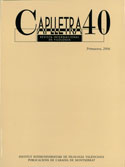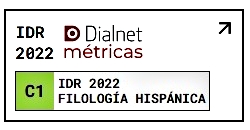Panoràmica de la traducció entre espanyol i català en els àmbits literari i audiovisual
DOI:
https://doi.org/10.7203/caplletra.40.4849Palabras clave:
Translation, Spanish, Catalan, Literature, audiovisual Media Resumen
Resumen
In this article the current situation of translation between Catalan and Spanish is drawn into two areas of speciality strongly intertwined: the literary and the audiovisual one.
The aim is to approach to a translation practice which is hardly known and studied. It is a young practice, still a minority but with its own traits and characteristics. Young, because we have had to wait for Catalan to start its normalization process before being able to find translations between Catalan and Spanish; a minority because it is not present in all professional areas; and it is not prototypical because it is a type of translation which does not necessarily abide to the criteria of intelligibility (which is, after all, the reason for being of the translation): translate to make understand. In the case of Catalan and Spanish it does not always obey to this purpose because both languages are known by most speakers of the Catalan-speaking zones.
The present work provides a revision of two of the areas in which it is present nowadays, such as the literary and the audiovisual ones, with the purpose of making this type of translation known in order to fill in an obvious gap in translation Studies. In consequence, the reasons that explain its presence or absence (many of them linked to political decisions) will be analysed as well as the trends that can be examined.
 Descargas
Descargas
Descargas
Publicado
Cómo citar
-
Resumen427
-
PDF (Català)238
Número
Sección
Licencia
El autor o autora que dirija un trabajo a la redacción de Caplletra para ser publicado tiene que ser la persona titular legítima de los derechos de explotación. La legitimación para la publicación del trabajo tiene que incluir también las imágenes, las tablas, los gráficos y otros materiales que puedan complementar el texto, con independencia de si es su autor o autora.
Copyright. Al publicar el trabajo en la revista, el autor o autora cede a Caplletra. Revista Internacional de Filologia los derechos de explotación (reproducción, distribución y comunicación pública), tanto para la edición impresa en papel como para la versión electrónica.
Todos los trabajos publicados en Caplletra se encuentran bajo una licencia Creative Commons del tipo Reconocimiento-NoComercial-SinObraDerivada 4.0.
RESPONSABILIDAD
Caplletra. Revista Internacional de Filologia no se identifica necesariamente con los puntos de vista sostenidos en los trabajos que publica.Caplletra. Revista Internacional de Filologia declina toda responsabilidad derivada de cualquier vulneración eventual de los derechos de propiedad intelectual que pudiera ser llevada a cabo por los autores o autoras.






